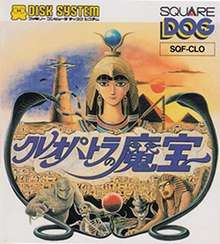Cleopatra no Mahō
Cleopatra no Mahō (クレオパトラの魔宝, Kureopatora no Mahō, lit. "Cursed Treasure of Cleopatra") is a Japanese role-playing video game developed and published by Square for the Family Computer Disk System, and released in Japan on 24 July 1987.[1] The game's music was composed by Nobuo Uematsu.[2]
| Cleopatra no Mahō | |
|---|---|
 | |
| Developer(s) | Square |
| Publisher(s) | Square |
| Composer(s) | Nobuo Uematsu |
| Platform(s) | Family Computer Disk System |
| Release |
|
| Genre(s) | Role-playing video game |
| Mode(s) | Single-player |
Gameplay
Players explore an Egyptian town and ruins from a first-person perspective. The game combines role-playing game elements with an adventure game-like interface. Players may purchase items from shops, though some shopkeepers must be defeated in battle before trading. Battles are turn-based, with options to fight, use items, or flee. Players accumulate experience points by succeeding in battle and "level up" after gaining enough experience, which increases their stamina. Randomly encountered battles with enemies may happen at any time, including when paused to examine the inventory.[3]
Plot
The player character, Daisuke Kusano, is the son of an archaeologist who disappeared while searching for the Tears of Isis, artifacts once owned by Cleopatra. During the man's excavation for the Tears, demons appeared and abducted him. The boy soon learns that he must find the Tears in order to save his father.[3][4] Over the course of the adventure, Daisuke visits the Great Sphinx of Giza, the Temple of Kom Ombo, a tower of sand, and an underground labyrinth. At the end of the game, he discovers that the demons had been disguised as the kindly shopkeeper. Daisuke receives the last Tear of Isis upon defeating the demons, which summons the ghost of Cleopatra, who releases Daisuke's father from imprisonment.[3]
Development
Nobuo Uematsu composed the music for the game.[5] When developing the game for both the Famicom and the Famicom Disk System (FDS), there were technical differences such as a smaller amount of memory on the FDS which led to a more difficult process creating the same graphics.[6]
Reception
| Reception | ||||||
|---|---|---|---|---|---|---|
| ||||||
Famitsu appreciated the game's graphics and animations, and called the characters "cute".[1] ITmedia Gamez also complimented the game's animations, though felt that too much of the disk's capacity was devoted to these animations at the cost of game length. However, the reviewer thought it was not a bad game, even though it was short, and compared it favorably to The Warlock of Firetop Mountain, an adventure gamebook.[3]
References
- "クレオパトラの魔宝 [ファミコン]". Famitsu (in Japanese). Archived from the original on 25 July 2015. Retrieved 25 July 2015.
- "N's Profile". Square Enix. Archived from the original on 2015-03-25. Retrieved 2016-02-06.
- ゲイムマン (13 June 2006). "アドベンチャー+RPG≒ゲームブック「クレオパトラの魔宝」" [Cursed Treasure of Cleopatra: RPG + Adventure = Story-driven game]. ITmedia Gamez (in Japanese). ITmedia. Archived from the original on 1 June 2015. Retrieved 20 May 2013.
- クレオパトラの魔宝 [Cursed Treasure of Cleopatra]. Square Enix Japan (in Japanese). Square Enix. Archived from the original on 20 April 2015. Retrieved 20 May 2013.
- "『キングスナイト』の曲は『ドルアーガの塔』を意識した──作曲家・植松伸夫が語るスクウェア初期作品の思い出". Den Faminico Gamer. December 14, 2016. Retrieved June 8, 2020.
- Szczepaniak, John (February 2018). The Untold History of Japanese Game Developers. 3. SMG Szczepaniak. p. 191.
External links
- Official website (in Japanese)